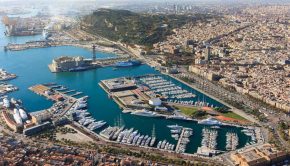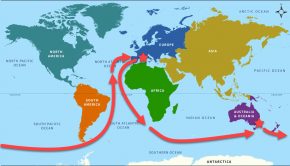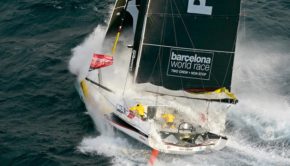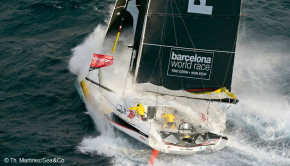A detour around the South Atlantic high
Published on January 13th, 2015
(January 13, 2015; Day 14) – Regularity and routine, such as they want it, has kicked in for the leaders of the Barcelona World Race as they race past the latitude of Recife, Brazil. Leaders Alex Thomson and Pepe Ribes were 260 miles east of the NE corner of Brazil and closest challengers Neutrogena, Guillermo Altadill and José Munoz are now about 80 miles further inshore.
There is still very little to separate the two IMOCA 60’s in what is essentially a boat speed race, straight line, on a close reach in the SE’ly trade winds, scrolling parallel lines down the South Atlantic chart.
Overhead weather is still pleasant, thoughts of the big south – six days away now – can be kept in abeyance, and the 15-18kts breeze and steep seas mean the autopilot does a better job , medium to long term – of steering the boats on this point of sail than its human counterparts. There is time to bank as much sleep as possible, check and double check everything, work through any jobs list, and just enjoy the even paced rhythm.
Ahead the South Atlantic high pressure is not too much of a conundrum. At the moment its position in the south and west simply means a long detour to the west, round the western perimeter of the elongated barrier of light winds which stretches almost all the way to the tip of South Africa. The system is set to split with multiple centres but as yet there does not seem to be any obvious short cut.
As third placed Cheminées Poujoulat co-skipper Bernard Stamm pointed out today, they are keeping their options open but simply descending south west, degree by degree, as fast as they can.
“We are perfectionists and so we are trimming all the time we can, but the pilot does a better job of steering than we can.” The Swiss sailor opined.
Recife, 285 miles west, is the most natural, full facilities point for a technical stop before heading on into the south. This edition the rules stipulate a technical stop is any stop to carry out repairs with external help. A maximum of three is permitted. A technical stop has a mandatory minimum duration of 24 hours.
At the same time in the last edition, in January 2011, both of the leaders broke away to stop in Recife, Foncia (Michel Desjoyeaux and Francois Gabart) and eventual winners Jean-Pierre Dick and Loick Peyron, on Virbac-Paprec 3 carried out running repairs, stopping at the same time, in fact somewhat bizarrely the duos ending up in adjacent rooms off the same hall in a house there.
None of the top three or four teams have reported any significant technical issues, testament to the preparation this time and the fact that all four of the top boats have done at least one circumnavigation before. In 2010-11 both these boats had been launched early in 2010 and had just done the Route du Rhum Transatlantic back to back with the Barcelona World Race start.
Renault Captur, Jorg Riechers and Sebastien Audigane, have now repositioned themselves back towards the west and the tracks of the top four boats. They crossed the Equator at 0940hrs UTC, 1 day 7hrs and 50 mins after Hugo Boss. Parallel course distance to the same latitude as Hugo Boss is now about 420 miles. At the Cape Verde Islands four days ago it was 140 miles. But the German-French partnership are now making good speeds with a little easterly leverage should they get a chance to make it work for them.
Stamm also underlined how closely matched the boats are and how that is producing a race which is much closer than probably any of the skippers really expected it to be. And a routing run for the two boats which are most to the south, Hugo Boss and Neutrogena has them still only an hour or two apart six days hence, as they head into the Southern Ocean.
Doldrums Sticking Point
The Garcia brothers finally put paid to their compatriots Aleix Gelabert and Didac Costa when We Are Water slipped past One Planet One Ocean/Pharmaton in the Doldrums. Sadly Gelabert and Costa were glued to the spot for a period, stuck under a cloud, and Bruno and Willy could sail wide to the east around them. They were 100 miles from the Equator this afternoon.
Skippers quotes
Bernard Stamm(SUI) Cheminées Poujoulat:
The descent (down the South Atlantic) is going to be quick enough, even with two high centres to pass. It is still a bit further ahead but in five or six days we will be in the South. We will have to make our choices on how to approach the high, how to stay quick and get to the stronger winds first. This is a speed race just to find your best course and angles. We are finding our way down, degree by degree. The pilot steers better than us, but the pace does not change, we are trimming all the time, we are perfectionists, both. All night there is only ever one of us sleeping.
We have learned about what has happened in France, but we feel quite cut off and isolated in our world at sea. We know some but have very little information.
We are not really surprised about the pace of the race. We are pleasantly surprised about how even the boats are. In terms of pure performance Hugo Boss is the quickest and sets the bar high, but the other boats are all very close.
When we got to the Doldrums we had a problem with the top halyards and it took a while to go up the mast and sort that out. And that was a pain, and we put the genoa in the water. It needed a clean so we dragged it for a while (laughs). And Jean has just finished cleaning the bilges!”
Bruno Garcia (ESP), We Are Water:
Explain the situation you have in the doldrums, what conditions you have?
We are moving from one cloud to another but last night we had bad luck because the cloud we got stuck under had lots of rain and no wind. That’s why we have been so slow.
When do you expect to pass the Equator?
I hope we will get over tomorrow but it depends on the doldrums. If we can get out today then we will get across tomorrow, and if not it will be the day after.
Are you happy with the performance of your boat?
Yes, we haven’t learnt yet how to really use all of its potential but the boat is fine, and it is a very good boat.
You’re really close to One Planet One Ocean, you passed them yesterday; are you having any kind of contact with Aleix and Didac?
Yes, we have contacted them via email because although we were close enough for VHF, we haven’t heard them. But we’ve exchanged a couple of nice mails so we have said hello.
Note: With the next waypoint off the Cape of Good Hope, the rankings below could prove to be misleading as certain teams work west to avoid the Saint Helena high pressure area in the South Atlantic. Click on tracker to confirm positions.
Ranking at 19:00 UTC:
1. Hugo Boss (Alex Thomson – Pepe Ribes) 20928.9 nm Distance to Finish
2. GAES Centros Auditivos (Anna Corbella – Gerard Marin) 59.3 nm Distance to Lead
3. Neutrogena (Guillermo Altadill – Jose Muñoz 72.7 nm DTL
4. Cheminées Poujoulat (Bernard Stamm – Jean Le Cam) 79.3 nm DTL
5. Renault Captur (Jörg Riechers – Sebastien Audigane) 146.0 nm DTL
6. We Are Water (Bruno Garcia – Willy Garcia) 296.7 nm DTL
7. One Planet One Ocean / Pharmaton (Aleix Gelabert – Didac Costa) 323.0 nm DTL
8. Spirit of Hungary (Nandor Fa – Conrad Colman) 711.8 nm DTL
Report by event media.
Background: The third edition of the Barcelona World Race is the only double-handed, non-stop, round the world race. Eight IMOCA 60 teams started December 31, 2014, with the intent to cover 23,450 nautical miles in a circumnavigation from Barcelona to Barcelona, putting the capes of Good Hope (South Africa), Leeuwin (Australia) and Horn (Chile) to port and the Antarctic to starboard. The finishes are forecasted for the end of March 2015.









 We’ll keep your information safe.
We’ll keep your information safe.